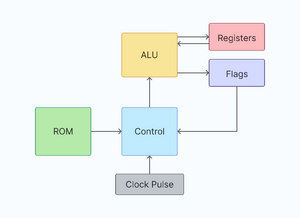Your First Computer: Difference between revisions
Lawrziepan (talk | contribs) This article now flows nicer, started a planning section |
Lawrziepan (talk | contribs) mNo edit summary |
||
| Line 15: | Line 15: | ||
=== The ROM === | === The ROM === | ||
The read only memory in our computer is where we are going to store all of the instructions for our computer. We aren’t looking for anything too big, so to keep with our data width of 8 bits, we will have 2^8 or 256 addresses in our ROM (this only needs to be addressed with 8 bits). And each address will store 8 bits of data for our instructions. | The read only memory in our computer is where we are going to store all of the instructions for our computer. We aren’t looking for anything too big, so to keep with our data width of 8 bits, we will have 2^8 or 256 addresses in our ROM (this only needs to be addressed with 8 bits). And each address will store 8 bits of data for our instructions. | ||
{{Todo|I will expand this article later}} | |||
Revision as of 22:05, 7 September 2025
If you're a new player, you might have already built a few circuits already: an adder, some kind of memory, a decoder. But getting to the next level where you have a functioning and turing complete computer, is incredibly daunting. This article will serve as a guide to how you might build your first computer.
Planning The Computer

While you might be inclined to jump head first into building, this results in at the very least messy building in Logic World, or a malfunctioning computer. In our computer we are going to first plan and document the capabilities our computer will have.
To start with the planning section, it helps to think about what this computer we are building is for. This could range from wanting to test out an ALU you built, or to perform a specific program you have in mind, e.g. matrix multiplication.
In this guide, our computer will be built as a way to learn each of the different parts of a computer, without any bells or whistles. So, we are going to give the computer the bare minimum.
Data Width
Data width refers to how many bits the binary numbers in our computer will use. This doesn’t have to be universal across an entire computer; for example, the memory might store in 32 bits, but our ALU only 16. In our computer however, we will use the same data width across our entire computer. While you can definitely go smaller, 8 bits is a good number to make it less complicated while being able to do a lot with our computer, so our data width is going to be 8 bits.
The ROM
The read only memory in our computer is where we are going to store all of the instructions for our computer. We aren’t looking for anything too big, so to keep with our data width of 8 bits, we will have 2^8 or 256 addresses in our ROM (this only needs to be addressed with 8 bits). And each address will store 8 bits of data for our instructions.

